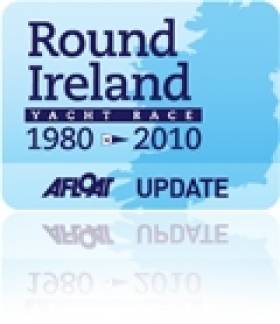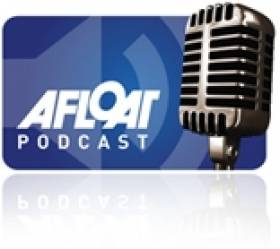Displaying items by tag: Round Ireland
Round Ireland Book Goes on Sale
Fred Drew, president and a former commodore of Wicklow SC, has launched a compilation of stories about the Round Ireland Yacht Race. The book goes on Sale next week from the publishers at Originalwriting.ie/bookshop/ or directly from WSC in June. Apart from two bookshops in town the book will not be available in main street bookshops
Racing Round Ireland is a collection of articles and stories about the Round Ireland Yacht Race which is held every two years and begins and ends in Wicklow.The race is organised and run by the Wicklow Sailing Club in association with the Royal Ocean Racing Club, the governing body for offshore racing.
Recognised as one of the most challenging events in the international offshore sailing world it has attracted some of the world’s greatest sailors and some of the most beautiful and iconic yachts.
But the backbone of the race is provided by the ‘ordinary’ Club sailor, some of whom have competed in the race ten or more times and the experiences of some of these in the 1994 race form the heart of this book.
Although Fred admits to never having sailed in the race himself (Although he knows someone who has) he has been associated with the race in one form or another since its inception.
In recent years he has been responsible for the race results programme and maintaining the race archive.
More on the Round Ireland Yacht Race:
Round Ireland Yacht Race 2010 Review
Round Ireland Yacht Race, Ireland's top offshore fixture
A Round up of 80 stories on the 2010 Round Ireland Yacht RaceICAP Leopard, the 100ft super-maxi racing yacht owned by Helical Bar PLC chief executive Mike Slade, is this week berthed in New York’s bustling financial district as she prepares to launch her assault upon the west-to-east monohull transatlantic sailing record in the coming weeks. Irish fans will remember this yacht holds the Round Ireland record after a spectacular circuit of Ireland in 2008.
Since her launch in 2007 ICAP Leopard has broken 12 major offshore racing records, including the fastest elapsed time ever set in the prestigious Rolex Fastnet Race. This voyage will see her tackle the well-trodden path between Ambrose Light, NY and the Lizard Point, which marks the entrance to the English Channel. Her target for this attempt will primarily be the record for monohull yachts with power-assisted systems of seven days, 19 hours and 21 minutes that she set in June 2008. However, since setting this benchmark the yacht has undergone a series of modifications and the crew are confident that, given the right conditions, Mari Cha IV’s outright monohull transatlantic speed record of 6 days 17 hours and 52 minutes will be achievable.
As with all major sailing record attempts, negotiating complex weather systems will play an integral role in ICAP Leopard’s latest transatlantic foray. The man responsible for the successful handling of the meteorological situation onboard will be veteran navigator Hugh Agnew.
Chris Sherlock, ICAP Leopard’s boat Captain commented: “We can’t wait to get stuck into another attempt on the Atlantic record. Last time a tight weather window forced us into accepting less than ideal conditions for our record run but we have slightly more leeway this time. Our weather window will open on the 11th May and then we will have roughly three weeks to plan our departure. This should allow us to set ourselves up for the best possible weather pattern.”
Owner Mike Slade commented: “This is something that I have been looking forward to ever since we crossed the finish line last time around. It has been brilliant to hold the record for yachts with power-assisted winches but we know we can go faster. The yacht and crew have been tempered over a two year period of hard racing and we are now sailing faster and harder than ever before. We will have a decent period of time in which to pick our weather window and the crew are all preparing to go on standby for what promises to be a thrilling sprint across the pond!”
ICAP Leopard will be carrying a GPS tracker that will allow spectators to follow her progress online at www.leopard3.com
Team Daft sponsorship formally announced
Property website Daft.com put its down payment on some prime publicity real estate today, formally announcing its plans to sponsor a boat in this year’s Round Ireland.
Daft will be backing blind adventurer Mark Pollock and Air Corps pilot Mick Liddy, the first double-handed crew with one blind member to compete in the Round Ireland Yacht Race.
The sponsorship deal will allow Liddy and Pollock charter a race-ready Class 40 for the event.
The announcement comes at a time when sponsorship deals for sailing individuals, never mind events, are at a premium. The Round Ireland Yacht Race itself has yet to secure a title sponsor, and other offshore sailors have struggled to retain sponsors or failed outright to raise funding for participation in higher-profile international events.
The motivation for Daft.com to come on board lies largely in the fact that Daft.ie is launching in the six counties of Ulster, making the company an all-island affair, which ties in nicely with a race around the island.
Said Pollock: “Securing a sponsor in these challenging economic times is very difficult and we feel extremely lucky to have the Daft brand behind us. For me, this competition is going to be the most challenging yet, as I will be operating the boat in two-hour shifts for the duration of the race. Unlike my previous challenges, I’ll be completely unguided. Having the support and backing of a sponsor like Daft.com means that I can focus entirely on the training and the race, knowing I have the Daft team right behind me.”
David Garland, Sales Director, Daft Media Group said, “I truly admire Mark as an individual and the manner in which he approaches every challenge he takes on. His commitment and determination to succeed is an inspiration to us all. We’re delighted to be in a position to be able to support and sponsor Mark and Mick in this high-profile sailing event.”
Bears, Marinas and offshore youth
It's a longer than usual podcast this week, as we speak to Irish sailor John Coffey, who's joining Bear Grylls on an RIB expedition through the Northwest passage, Hal Bleakley on handing in his cap and badge at Dun Laoghaire marina, and Wicklow's youth Round Ireland challenge.
Navigating Round Ireland Tips
Plotting for going round – part I
The well-organised navigator will already have a game plan for the BMW Round Ireland Race. Course veteran Brian Mathews shares some of the secrets of this 704-mile classic
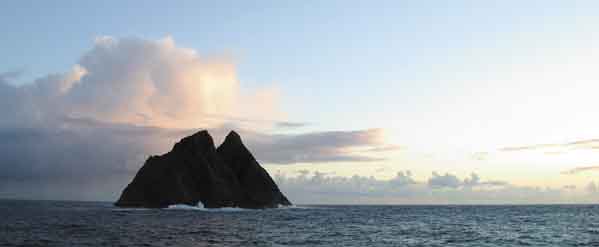
A mark on the course – the Skelligs rock off the Kerry coast is a turning point Photo: David Branigan
First steps first is the answer to sound preparation for the Round Ireland. All homework should be completed no less than two weeks ahead of the start – a stress-free approach is the hallmark of good navigation. We’ll assume for this article that the safety side of preparations is being taken care of by the skipper. Remember that survival, first aid, previous experience and other race and ORC requirements cannot be overlooked.
Basic navigation strategy follows standard practice and a good passage plan will save you from endless grief during the race. My own preference is for IMRAY charts as they fit small yachts better than Admiralty editions, are water-resistant and are latticed with Lat/Long for faster plotting. While you can correct existing charts, it’s better not to try to save the few euro that a new edition will cost.
Plot your rhumb-line course for the race, taking care to note the organiser’s stipulations on navigation. It’s not simply a case of leaving Ireland and its islands to starboard – it’s too easy to get caught out by marks on the course such as the Conningbeg and the Fastnet.
As with any passage plan, note the waypoints and the Lat/Long for each leg with the course and distance in sequence. Again in sequence, add Pilotage notes to each stage as well as transferring the complete plan to a ‘Wet Notes’ pad.
By race day, the passage plan should be finalised and committed both to paper and to memory too, if possible. Attending the official briefing with the skipper is both mandatory and essential. Expect considerable emphasis on the reporting requirements as well as the usual amendments to sailing instructions. The 72-hour forecast from Met Eireann will also be available – the fax version is preferred.
Be at the start line no later than one hour beforehand and motor to Wicklow Head to check the true wind as there’s often a different breeze off the harbour. Back to the starting line and it’s time to brief the crew on your plan and what to expect – avoid excessive detail. Having a keen picture of your plan in your mind will avoid the need for constant trips to the chart table – hatch rat navigators are bad for morale. From the gun and for the opening stage of the race, aim to sail inside the Arklow Bank, irrespective of the wind direction as the tide will be flooding this year. This should mean arriving at the Blackwater Bank with the young ebb and from here heading outside the banks to the Tuskar.
This ebb should get most of the fleet around the Tuskar Rock, one of the major tidal gates in the race, but it’s possible that some of the smaller boats won’t make it in time. If it does look like you’ll luck out on a foul tide, plan to be inshore so that you can kedge if necessary. If you have to anchor, remember your light by night and shape in daylight – the IRPCS apply to all vessels at sea, at all times.
Right about now, your homework will pay off as Rosslare is a busy ferry port and sailing times can be found on the web. Expect traffic off Dunmore East at the Waterford Estuary on the high tide and at Cork too.
By the Tuskar rounding, it will be dusk or darkness for the majority of the fleet. A reducing distance/time/ boatspeed matrix for the first stage from the start to the Tuskar Rock (approx 49nm) will enable you to plan the watch system for the crew.
The loom of the Conningbeg 20 miles away should be visible and coming abeam of it will mark your first chance to grab some rest. Navigation tactics for the south coast boil down to wind direction: following breeze equals a rhumb-line course while headwinds demand tacking for the shore, across the chop but on the paying tack as much as possible. If the former, warn the helm of the danger of straying from the course – this next leg from the Conningbeg to the Old Head of Kinsale is 75 miles, so even a five-degree error can be costly.
In previous races, we have even noticed magnetic anomalies during rain and electrical activity in this area so – be vigilant, keeping in mind that B&G systems also work off a magnetic and fluxgate system.
The silhouette of the Saltees, inshore of the Conningbeg Light followed by Hook Head, Mine Head and Ballycotton lights are useful references on the course past Roche’s Point, hopefully by dawn. Salmon nets are a significant hazard from Mine Head onwards and you shouldn’t need to be inshore before this.
The tide on the south coast is relatively light but the percentage gain improves as the wind goes light. Often a visual tide-line can be observed between headlands so plan to sail in the bays during the flood.
The stage from the Old Head to the Fastnet is a 42-mile leg and another rhumb-line course unless headwinds force you to tack inshore. Major hazards here include The Stags between Glandore and Baltimore and the wreck of the Kowloon Bridge that is buoyed.
COPYRIGHT AFLOAT 2004
Make or break – part II
Round Ireland veteran Brian Mathews concludes his guide to navigating the 704-mile classic with advice on the stages that will decide how – and if – you finish
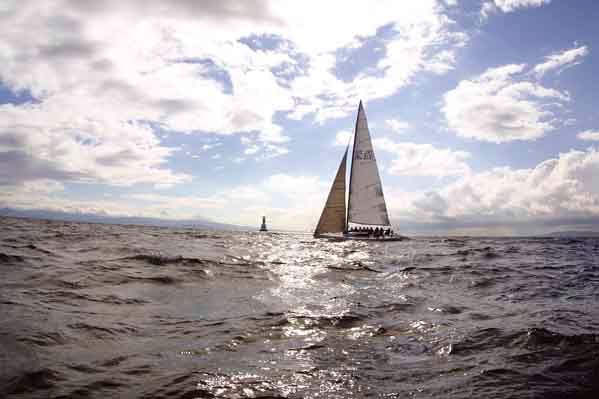
The Kish Lighthouse marking the entrance to Dublin Bay is the final waypoint before the finish and the rhumb runs straight down the centre of the bank. If the tide is foul here, sail inshore. Otherwise take the ebb south to the finish. Our picture shows Frank Clarke’s Sapphire, well up on corrected time, passing outside the lighthouse in the last hours of the 2002 race. Photo: David O’Brien
In the last issue of Afloat, we concentrated on the importance of proper preparation and a carefully considered passage plan. Our first stage of the race has taken us to the Fastnet Rock and this usually marks the point where those with the ability to last the course begin to separate from those without it.
From the Fastnet, a series of headlands mark the entrances to the large bays of the south-west coast – the Mizen, Bull Rocks, Skelligs and Innistearacht are all clearing marks on the course and should hopefully be rhumb line sailing past each. If beating around this stage, tack into the bays for a lift off the headlands coming out, as well as taking the benefit of calmer waters inshore. Above all, strictly no flyers out to sea around here!
In your passage notes, don't forget the various isolated rocks on this stage such as the Bull Rock with its attendant Cow and Calf rocks too. Check the charts carefully and remember, these are unlit hazards.
Turning onto the west coast from Innistearacht is usually a relief and a major psychological boost for the crew. Up until now, the race has been an investment of pain – now it’s time for gain. At last the open waters of the Atlantic and their long swells stand to offer the best boatspeed potential. This is also the first time you're likely to lose sight of land after leaving the Kerry coastline until your landfall off Connemara with its back-drop of the Twelve-Bens mountains.
Ports of refuge should also be part of your planning – there is a range of options after the West Cork coast and not all will suit in every condition. Castletownberehaven must be approached from the east in strong gales whilst Smerwick Harbour after Innistearacht is a natural anchorage except in north-west gales. The marinas at Dingle, Cahirciveen and Fenit are very welcome recent developments; Kilrush Marina on the Shannon Estuary is some way off the course but is another option. After here, the leeside of Aran Mor breaks the gap between Kerry and the next shelter at Broadhaven Bay near Belmullet.
Nevertheless, previous races would suggest that if you've made it this far, the trigger has been pulled and, barring serious damage or injury, you'll be determined to reach the finish.
From the north-west coast onwards, different strategies will evolve as the fleet will have become spread out and the leaders are likely to be experiencing completely different conditions than the back-markers.
Typically, the first boats could be at Eagle Island while the last boats are still on the south-west coast. But the race decider has yet to come into play.
On reaching the north coast, tide once again becomes a factor and a substantial one at that. This is the ‘Salmon Highway’ and nets up to three miles long will be everywhere at this time of year. These will normally be well-tended and best advice seems to be that if the attendant fishing boat is underway at speed, she will be shooting her nets so it should be obvious where they are. If stationary, sail for the fishing boat as it will normally mark the end of the net – monitor the radio as you are likely to receive instructions on the best way to avoid a fouling. Should this happen, a long pole with a split end can be used to push the net down below the keel and clear astern without cutting or damaging the gear.
Entering the North Channel between the Ulster coast and Scotland will see the strongest tides of the entire race. Bear in mind that the tide floods south in the stretch before reversing in the north Irish Sea. Three major tidal gates form close to Tory, Rathlin and the Maidens. The best advice in a foul tide seems to be to sail inshore and go for mid-channel with the flood. Plan ahead for where you want to be when the tide changes next. Also be prepared to kedge if the breeze dies along this leg.
The Antrim plateau often causes wind-sheer so be prepared for constant changes of wind direction. Conversely, the Mournes create shadow so Dundrum Bay on the north-east coast should be avoided at all costs. The tide is neutral in here but don't be lured by its apparent attractiveness.
From here on is where the race will be won or lost. Most likely it will be the last night at sea but don't suspend the watch system because of this – anything can yet happen and even though the finish will be in sight, the wind can and does die. The Kish Lighthouse marks the final waypoint before the finish and the rhumb runs straight down the centre of the bank. If the tide is foul here, sail inshore. Otherwise take the ebb south to the finish.
Key points to remember:
• The tidal atlas will be your bible
• Prepare a detailed passage plan
• Keep a balanced watch system
• Swing your compass and keep a deviation card handy
• Rigidly observe the race rules for radio check-in points
• Complete your safety preparations and gear checks in full
COPYRIGHT AFLOAT 2004
Please note: These tips are intended as a guide only. Views expressed are not necessarily those of the publisher.
More on the Round Ireland Yacht Race:
Round Ireland Yacht Race 2010 Review
Round Ireland Yacht Race, Ireland's top offshore fixture
A Round up of 80 stories on the 2010 Round Ireland Yacht RaceRound Ireland Race, Ireland's Top Offshore Sailing Fixture
2012 will mark the 32nd anniversary of Ireland's premier off-shore sailing event, the Round Ireland Yacht Race, organised by Wicklow Sailing Club in association with RORC.
For the first time the biennial Round Ireland Race counts for the same points as the Fastnet race in the Royal Ocean Racing Club events (RORC). This is a huge boost for Wicklow Sailing Club Wicklow's Chairman of the event, Dennis Noonan expects a strong Irish turnout for the event in June.
The Round Ireland Yacht Race will depart from Wicklow Bay at 12 noon on Sunday 24th June 2012, leaving Ireland and all its islands to starboard. It is the longest race in the Royal Ocean Racing Club calendar, comparable to similar Offshore Races such as the Fastnet, Malta Middle Sea, Sydney-Hobart and China Sea races. The first race took place in 1980 with only thirteen boats. Since then, in the biennial race, the fleet has grown steadily, and some 30 to 40 yachts are expected to be at the start line in 2012.
Click this link for all the latest Round Ireland Sailing News
Sailing around Ireland poses many challenges for boats and crew, with open ocean on the south and west coasts, tidal challenges on north and east coasts apart from all the off lying rocks and sandbanks to keep navigators on their toes and not forgetting the vagaries of the Atlantic weather systems. This is very much a sailors' race but armchair spectators can follow the race on their computers, thanks to modern race tracker technology.
A Round Ireland Sail Fest (Thur 21 – Sun 24 June) will complement the race preparations and add a welcome level of fun and entertainment always provided for those travelling to Wicklow for the race start.
2010 Race
There are four classes in IRC in which boats and their crews can compete, including a Classic Class for the Michael Jones Trophy, classes for Sigma, ISORA, IRM, a Team Prize. 2004 saw the launch of the Two-Handed Class which has introduced a new level of competition for the more extreme sailor. In the past, boats competing have ranged from an 84-footer former 'Round the World' maxi to club boats one third the size, and all shades in between.
2006 saw the largest yacht yet to partake – Konica Minolta Zana, a 30m (98') racing machine from New Zealand, but light winds scuppered her chances of breaking the record or winning the race.
Sunday the 20th of June 2010 will be the 30th anniversary of the First Round Ireland.
There are very few human emotions left untouched by participation in the Round Ireland Race. Elation, fear, despair, and joy – they're the obvious ones. But as well there's love – love of our country and it's extraordinary coastline. Sailing the 704-mile course is an expression of that profound feeling.
Even the most hardened racer returns from the campaign emotionally enriched. But of course, as the pre-start manoeuvring builds up off the Wicklow pierheads, it's the sporting challenge of the race which is uppermost. The fine thoughts can come later for, at the start, everything is aimed at coping with the sailing, navigational and technical problems which this great race inevitable involves.
Seven-hundred-and-four miles may not seem much at first sight, but think of what it contains when its the shortest distance round Ireland and her islands. Four very different coastlines have to be negotiated as well as as a host of headlands, rocks and sandbanks.
And then there's the tides – as the ebb sluices away from Wicklow down past the banks of the southeast, that's only the beginning of it.
For immediately you're in the battle to carry that one ebb all the way south, past the Tuskar and out past the Coningbeg until you reach the slacker tides off the Waterford coast.
Getting that far might be cause for relaxation, but in the 1990 race the fleet had a beat along the supposedly gentler south coast into a near gale which sorted them out in a big way with dismastings and other damage.
At both the Old Head of Kinsale and Ireland's 'land's end' of Mizen Head, tides again become significant, while along the southwstern seaboard there's another unexpected hazard. The coastline is so spectacularly beautiful, with dramatic off-lying rock giants such as the Bull and the Skelligs, that crews can be awed and distracted by it all.
At each outcrop of the Irish land is approached, race navigation can more accurately be described as pilotage. Cutting the corners as closely as possible can save valuable time, but cutting the corners too close can result in disaster. The sheer scale of the corners you're rounding naturally inspires respect – wherever else he or she may sail afterards, few navigators will ever forget rounding the most westerly point of the race – the Great Foze Rock out beyond the Blaskets.
Because the race is outside every rock and islet, special difficulties arise at two specific points. At both Black Rock in Mayo and the most northerly point, Inishtrahull off Donegal, the safest water is actually inside the rocks in question. Thus they are marked by lighthouses which are meant to guide you through the clearer inside passages. But the rules say you take the hazardous route outside. It can be difficult on a dark and stormy night, to say the least, but such challenges are what the Round Ireland Race is all about.
And there's no rest on the open water stretches such as those between the Blaskets and Slyne Head, or from Eagle Island to Tory. There can be surprising variations in wind strength and direction crossing these great bays, even over short distances, and when it's a beat – as it was in 1986 up the west coast – the right tactical decisions paid enormous dividends.
Off the Donegal coast there's the added problem of salmon nets. Whether they're legal or not is beside the point: they're there and you have to deal with them and their owners as best you can.
Once the extraordinary island of Tory is astern, newcomers to the race tend to relax a bit, thinking that open water is a thing of the past, and rough sailing with it. Not a bit of it. For as you near Inishtrahull, the tides strengthen rapidly and all the way from Inishtrahull through the narrow seas of the North Channel until the South Rock is reached, if wind over tide occurs then you're in very rough water indeed, particularly off Rathlin Island.
It would be understandable to ease off a little once the South Rock is passed. After all, you're on the home straight, this is the griendly old Irish Sea, and there's only a hundred easy miles to the finish.
The race has been lost by such an attitude. never is it more necessary to keep up the pressure. And, as you get into strong tides from Rockabill southward, hard-gained leads which have been built up over 650 miles can simply evaporate in flukey winds and foul tides.
So it is never over until you've passed the orange buoy off the Wicklow pierheads. And after that, it's only the actual sailing which is over.
The memories become enriched as time passes, and even the parites could be said to go on until well into the autumn, when the sponsors host the prize-giving. If you want to experience the genuine camaraderie of sailing folk, then this is one event not to be missed.
Ready for Ireland (reprinted from the May 2004 issue of Afloat)
The Round Ireland is not for the faint-hearted nor the unprepared. David Nixon describes the battle to get a competitive boat to the start line
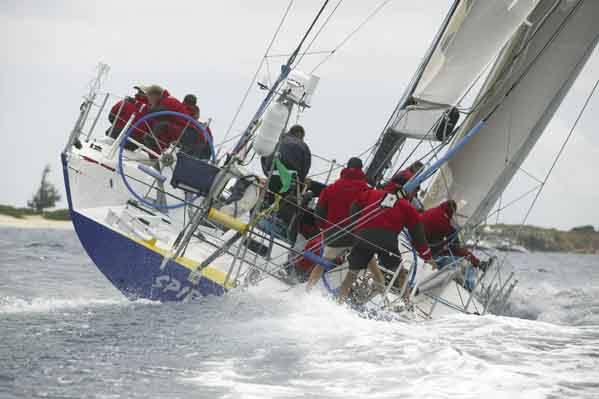
Above: Spirit will add spice to the BMW Round Ireland 2004 in Irish waters thanks to a Howth YC campaign. Photo Tim Wright
My last attempt to skipper a Round Ireland was in 1996 when, as a group of insane teenagers, we thought it would be a great idea to compile a Youth Challenge for the race. I’m happy to say we didn’t see it through, because I’m sure that if we had pursued that dream, none of us would have lived to tell the tale. I have learned since that offshore sailing is not quite as easy as it seems.
Last August, I got the call from Fred and Jim, who were in Plymouth having just finished the Fastnet Race. They urged me to put pen to paper for a significant Round Ireland entry. I began a proposal that day and now it’s finally beginning to come to fruition. The pleasant part of planning has been the support we have enjoyed. It has been really positive and uplifting for me and the team. It hasn’t all been easy but we are determined to see it through to the finish. Wicklow here we come!
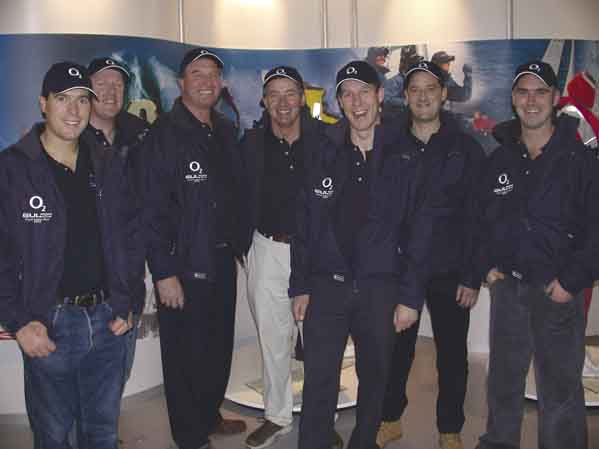
Above: Lift off – At the launch of Howth's Round Ireland campaign on the GUL stand at the London Boat Show are (left to right) Spirit's owner Hamish Oliphant, Irish Olympian Tom McWilliam, Veteran Jim Barden, Ireland's Round the World Skipper Joe English, O2's Round Ireland entry Skipper David Nixon, Fred Connolly and David Howard. Photo: Mark Jardine
I missed the last Round Ireland. While it was pleasant getting into a warm and comfortable bed on the night of the start, a little drunk, I couldn’t help but feel disappointed I wasn’t taking part. The Round Ireland is a magical race, I can’t quite say why, but it is magic. I guess with so many corners to turn and fabulous landmarks to pass, you can’t help but enjoy it.
However, my favourite part of the Round Ireland is the finish, something I think I share with all other sailors. I remember on board Cracklin’ in 98, we were off Rathlin and Jeep Cherokee had finished. How we envied them – pints and steaks all round in Wicklow Sailing Club. At that stage I realised we needed a faster boat.
Drawing up my current plan, I asked myself whether I could see it through. Happily I was reassured by a number of people around me, namely Jimmy Barden, Fred Connolly and Davie Howard. My brother was also very encouraging which was important as he has nothing to do with sailing – he just knew I’d do it.
My other question was whether I could actually skipper a substantial team racing a high performance racing machine. That can only be answered during the race, but my team believe I can and, with their support, anything is possible. I’m 26, and while my knowledge and experience may be somewhat limited, it’s the team that makes a crew and the attitude and approach of that crew that can bring the boat to victory.
The plan was simple from the start; procure the best resources available to give us the best possible chance to win the race and beat the record. Fundamentally that meant attaining sound and substantial sponsorship – not an easy task. It then meant finding the most suitable boat available and recruiting an appropriate pro-am crew. Pros were a must, but so too were amateurs since that’s a major feature of the campaign.
Ireland has a wealth of amateur sailors with excellent skills, knowledge and experience. The challenge, I believe, is to develop this to compete on the international scene. Having competed in the 2002 Commodores’ Cup, I feel there is a gulf between Ireland’s available resources and that required to compete at the highest level.
I had the opportunity to learn about the level of ability among professional ranks in 1998 when Roy Dickson kindly sent me off with Cracklin’ to race with a fully professional team on Barlo Plastics. We won, and it taught me a lot.
As an amateur, I feel the best way to improve my own ability is to race with professionals any chance I get. This pro-am mix is the philosophy of the modern day Commodores’ Cup, but it costs to live it. Commercial support in the form of sponsorship is essential to pay the bills.
So our Round Ireland project has longer term relevance. It provides us with training in two very important ways – sponsorship attainment and learning from professionals.
So how did we do it? Well, as with most things, there has been an element of luck. I called a colleague to help me with the proposal document and he liked the concept, so O2 got involved. Davie Howard has the GUL agency in his ProRig store so he put me in touch there and they also liked the plan. A couple of other sponsors have come on board since.
In the meantime we were looking for a boat, a search which proved quite difficult. The web and contacts are great but amazingly there are not that many good offshore boats available for charter. In the end we were very fortunate to get in touch with Pure Sailing, a Plymouth-based charter company with a VO 60, (Tyco from the last Volvo Ocean Race). Hamish Oliphant, the owner, was very interested by our proposal and signed up to the campaign.
 Left: The big one – A Volvo 60 will Race round Ireland under a Howth flag. Photo: Tim Wright
Left: The big one – A Volvo 60 will Race round Ireland under a Howth flag. Photo: Tim Wright
Finally the crew. We had a long list of our own guys that we wanted on the team, but it was essential to put together the right team. Jim Barden had the tough job of final selection. We got in touch with Tom McWilliam who agreed to sail with us and brought in Steve Hayles and Guy Salter, both of whom had raced on Tyco for the VOR. I also asked Joe English and Davie Harte onto the team. The owner brings three, taking the total number of pros to eight. We will compliment this with ten amateurs, most of whom would have sailed aboard Cracklin’ Rosie with Jim and I.
Time has flown in development of this campaign. Before we know it we’ll be lining up at the start in Wicklow. I can’t wait. The competition will be great, the race will be excellent. Even better, the finish in Wicklow awaits with pints and steaks all round. That’s what it’s all about!
Royal Cork stake early claim
Five of the nine entries received so far for the June 26 start of the BMW Round Ireland race are from Royal Cork in a fleet that Wicklow organisers ultimately expect to swell three-fold by the entry deadline of May 24.
The largest entry continues to be the Volvo 60 Spirit (David Nixon, Howth) but there are other big boats on the horizon according to organiser Denis Noonan.
A single entry has been received in the new two-handed class and it comes from the Isle of Man Yacht Club in the form of Andrew Bell's J105 sloop, Moontiger.
Dingle pair to take on Ireland
Co-skippers Aodhán Fitzgerald from Dingle and Frenchman Yannick Lemonnier will go head-to-head with fully crewed entries in the 704-mile Round Ireland race this year.
The pair aim to compete both in the two-handed class of the race as well as the overall fully-crewed IRC category.
Both co-skippers have impressive sailing credentials. Lemonnier competed in the Figaro single handed racing events for five years before he moved to Ireland in 2001. He has also competed in several two-handed transatlantic races as well as several Tour de France a Voile series.
Fitzgerald has been active in the Irish offshore racing scene for ten years, campaigning on the well-travelled GK 34 Joggernaut for the past eight years. Aodhan has competed in four Round Ireland races and two Fastnet races. Successes include an overall win in the 1999 Dún Laoghaire to Dingle race.
The team’s longer term ambitions include competing in next year’s Fastnet Race (two handed division) as a warm-up for the two handed transatlantic AG2R race in 2006. Further details can be found on the team’s website www.dinglesailing.com
COPYRIGHT AFLOAT 2004
Time out, round 13 (reprinted from the July 2004 issue of Afloat)
A showdown not witnessed in ten years is on the cards for the BMW Round Ireland Race as a surge of interest has seen a 60 per cent jump in entries from five countries for the 704-mile race

Above: With variable displacement, an IRC rating of 1.425, a canting keel and powerful sailplan French entry Solune’s performance is designed to match a Volvo upwind and an Open 60 offwind
Looking back over the past decade or more, it is clear that the only thing predictable about the Round Ireland race – and we are about to embark on the 13th – is it’s unpredictability. So will the 13th staging of Ireland’s classic offshore race be unlucky for some? Almost certainly, yes.
With a little over a week remaining before the start of the 704-mile BMW Round Ireland Race, entries have exceeded organisers' expectations and presently stand at 47 boats from five countries with further late entries tipping the 50 mark.
The non-stop race for monohull yachts gets underway at 14.00 hrs on Saturday June 26th 2004 from Wicklow Sailing Club and the first boats will be expected to finish just three days later following their southabout circumnavigation.
 Left: Denis Noonan all set for his third and final Round Ireland as race organiser
Left: Denis Noonan all set for his third and final Round Ireland as race organiser
Commenting on the entry, Race Director Denis Noonan said: "The response has been very encouraging as we had initially hoped that we might reach 40 boats. The introduction of a two-handed class is a factor and BMW’s sponsorship has helped raise the profile of the race considerably."
French giant aims to crush Irish Spirit
A war of words has broken out between the main contenders for this year’s Round Ireland title, as the fleet of 50 boats makes final preparations for the event.
Paris-based financier Jean Pierre Chomett has thrown down the gauntlet to main rival David Nixon by declaring that he has entered the record-breaking 60-footer Solune not only to win on the water but also to smash the race record.
Six years ago, Colm Barrington in Jeep Cherokee set a mark of three days, four hours and 23 minutes for the 704-mile course, (see 'Records...' below) but Chomett believes a sub-three-day time is possible.
In setting the Round Britain and Ireland record in May, Solune reached top speeds of 26 knots in short surf, but also managed to average 22 knots for long periods of the voyage. It’s all weather dependent, of course, but Chomett believes the new design – a cross between a Volvo and open 60 design – has a better upwind performance than the Volvo 60 in both light and strong winds, a key sailing angle in the Round Ireland event where up to half the race can be spent on that point of sailing.
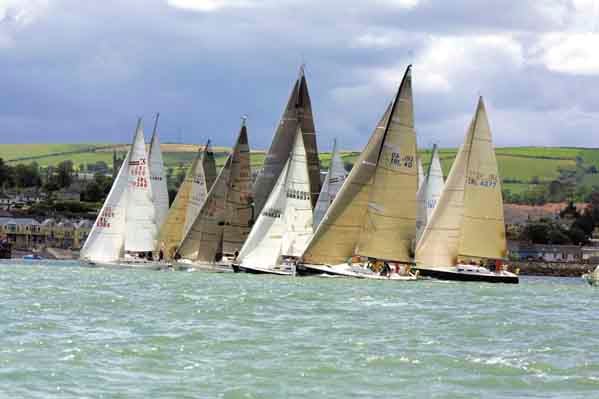
Above: The 2002 fleet departs Wicklow. Two years later the fleet has doubled in size and stature
However, 02 Team Spirit skipper David Nixon (26), who has chartered the Volvo 60 from the UK for the event, has dismissed the performance boasts of the French prototype. "As long as there’s breeze, we'll be okay," said the Howth skipper.
Built by the same team that created the Alinghi America's cup hulls, Solune broke the Round Britain and Ireland record by more than three days and 15 hours ahead of the previous record, a month ago. It was during that trip off the Irish west coast that Chomett made up his mind to return for a second record-breaking attempt.
There’s little doubt that the La Rochelle entry is up to the job. The broad-beamed boat comes complete with powerful gennaker, twin rudders and a canting keel. For the circumnavigation, Chomett will have Playstation's weather router and navigator Chris Tibbs of Cowes on board.
A third big boat for the fleet will be Dutch entry Second Love, a Standfast 64 that’s unlikely to prove a significant threat to the other pair as this boat is a Fast Cruiser design and lacks the performance advantages of stripped out interiors and lightweight equipment.
Nevertheless, this race is not about line honours or even a new course record – both are not part of the official event programme. The overall win is based on corrected handicap time that may yet give the Dutch boat an advantage.
Records
Records show how that between 1980s first race and Colm Barrington’s 1998 current record run that nearly 60 hours have been shaved off the circuit time. The race is on to be first round Ireland in under three days.
135:02:27 1980 Force ten-sion J.S. Morris, Pwhelli
99:45:25 1982 Moonduster Denis Doyle, RCYC
88:15:43 1984 Moonduster Denis Doyle, RCYC
84:56:06 1990 Rothmans Lawrie Smith, Royal Thames
76: 23:57 1998 Jeep Cherokee Colm Barrington, RIYC
Small may yet be beautiful
It’s all very well two big boats vying for the win on the water but as race followers know well the overall prize on corrected time typically only becomes clear once the small boats are back in Wicklow. Challenging the big boats for the race win in 2004 falls to a host of smart contenders of widely varying size; the recent light-airs RORC Cervantes Trophy Race in class zero featured three Round Ireland entries that illustrate this variety.
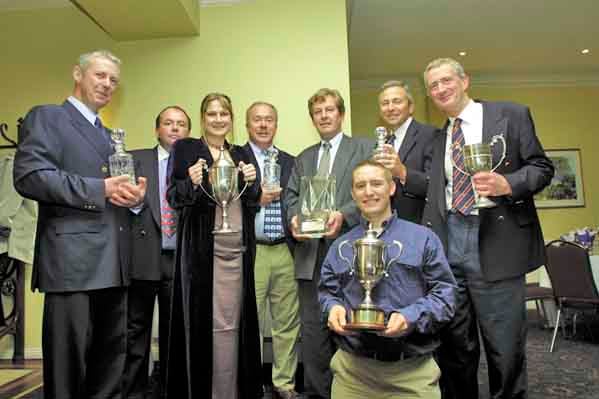
Royal Cork’s Eric Lisson (third from right) celebrates with the Cavatina crew after the 2002 race
Piet Vroon's 52-foot Tonnerre de Breskens, the Dutch winner of the 2001 Rolex Fastnet Race, took one hour off Anthony Richard's Minnie the Moocher, a Kerr 11.3 which in turn was 36 minutes ahead of Second Love after 110-miles of racing. For the Round Ireland, a large gap between the first, big boat finishers and the rest of the fleet finishing at Wicklow seems unlikely.
The list of handicap contenders must include another Jason Kerr design that has consistently proven problematic for bigger rivals and now has its sights set on this classic offshore course – Voodoo Chile, to be known as Calyx Voice & Data under Eamon Crosbie and his regular team from the National YC. As one of the smallest boats in the race, line honours is not an option for this 32-footer.
But Crosbie won't be the only smaller boat giving the big boys palpitations as they wait out the finishers at Wicklow Sailing Club. Eric Lisson and his Granada 38 Cavatina will be defending the 2002 title victory and, as the second-last finisher two years ago, nobody will be counting results on the basis of outside chances again.
Less predictable will be the new innovation for the 2004 race – a two-handed class that has attracted at least six entries. This will be a particularly tough challenge for some boats that range in size from 30 to 45 feet. One of the first entries came from Dingle pair Aodhan Fitzgerald and Yannick Lemonnier (see May Afloat), who have chartered Figaro Beneteau number 32, which has just arrived back from St Barths after completing the AG2R transatlantic. Entries in this class appear very competitive, with English interest centred on Thunder 2, a former winner of Cork Week class 0.

Left: Giant killer – Last time round in 2002, the Cavatina win came as such a shock that there was not even a picture of the boat available. The press had to make do with a shot of the comparatively petit and elderly Granada 38 footer on her moorings in the Curabinny river!
Overall, the revival in fortunes for the Round Ireland is to be welcomed and the increasing turnout is a testimony to the basic attraction of the race. The sheer unpredictability of the course, which fails to guarantee outright victory to the all-out racers, acts as a balance for the club crew and keeps the event within its original ethos.
Moreover, while just a handful of prizes are up for grabs, simply completing this challenging but achievable course places the event as a ‘must do’ for many crews and acts as an incentive to continue racing, often against the odds. For that reason alone, the Round Ireland has proven that reports of the death of offshore racing are very much exaggerated.
COPYRIGHT AFLOAT 2004
Here we go – Round 14 (reprinted from the June/July 2006 issue of Afloat)
The 100-foot Kiwi Pot-Hunter has arrived in search of a record. Afloat previews a 2006 Round Ireland fleet that has plenty of spice
At 4pm on July the 1st the BMW Round Ireland Yacht Race will set off from Wicklow Sailing Club. This year will be the 14th race to date and Wicklow Sailing Club officials are saying it will be one of the best and entries are still coming in well after the entry deadline so 2004’s 49-boat fleet could well be matched.
Race Organiser Denis Noonan had 41 entries as Afloat went to press (on June 16th) but is confident this figure should reach ‘in the region of the fifty mark’ as the big day draws near.
Either way, any deficiency in numbers is more than made up for in variety and this year Wicklow welcomes it's largest entry to date.
Owned by Stewart Thwaites, the record breaking yacht, 'Konica Minolta Zana' is a 30m super maxi yacht. She is due in Dublin in June with the intention of adding a Round Ireland Race record to an already formidable list of record times which she holds. The current record of 76hrs, 23 minutes and 57 seconds was set by Colm Barrington in Jeep Cherokee in 1998.
This will be the only competitive racing that the New Zealand yacht – sponsored by Lakeshore Funds – will participate in before heading down to the Mediterranean to compete in a number of events that include the Middle Sea race as well as the Maxi World Cup.
It was hoped that she could compete in Cork Week also, but this plan was scuppered by time constraints.
Konica Minolta Zana currently holds race records for the HSBC Coastal Classic Race, the Auckland to Suva race and the Auckland to Noumea race, as well as a string of top finishing positions in the Sydney Hobart.
Aboard Konica Minolta Zana will be a plethora of top class international sailors including Gavin Brady (watch captain), multiple world champion, Americas Cup and Volvo sailor, Steve Hayles, (navigator) ex-Oracle and with four Whitbread/Volvo races under his belt, Rodney Keenan (watch captain) ex-Volvo, etc., Kip Stone, first in Open 50s single handed yachts.
Among her crew will be Martin Hannon, originally from Newtownards who now lives in New Zealand. Adding a bit of local knowledge to the team will be GP champion Ruan O'Tiarnaigh.
However, size does not always matter in a race of this magnitude, with past winners including Calyx Voice & Data, Imp, and Cavatina all weighting-in at 40 foot and under.
One of the smallest boats in the fleet, Eamon Crosbie’s 32 footer Voodoo Chile (last time known as Calyx Voice & Data) is back racing as Teng Tools to retain his title.
Ireland West Tourism and Ireland West Airport Knock have joined in sponsoring an entry.
Aodhán Fitzgerald, winner of the 2004 Round Ireland two-handed class with Yannick Lemonnier, heads the twelve strong Team Ireland West, drawn from the membership of Galway Bay Sailing Club. They will be sailing a race-optimised Beneteau 40.7 yacht, chartered specially for the event, under the name ‘Ireland's West’. Well-known Galway sailor Barry Heskin will be watch leader, while Galway man Noel Butler, a former Laser 2 World Champion and helm of the winning boat in Class 1 at the UK's Cowes week last year, will be principal helmsman.
Another west coast entry are upping the ante with the charter of a Volvo 60. The group, known as the Spirit of Kilrush team, will have Simon McGibney among its crew. They have completed a number of training sessions on the boat in Cowes.
J.P. Chomette, on board Solune who holds the Round Ireland monohull record, is back and this time means business after some reworking of his canting keel 60-footer. Navigator Chris Tibbs is on board the French entry again.
This year will again be a very special one in our Double Handed Fleet, which already boasts Nunatak, skippered by Mike Jacques, and Moontiger driven by Alan Bell.
Yannick Lemonnier and Mark Greely of Dingle, Sailing Club, are fine-tuning their Beneteau Figaro 2 which they’re chartering with the support of their sponsor Southbound Group in the two-handed category.
Yannick and Mark have been sailing together for a number of years and came second in the Dun Laoghaire to Dingle race on board Southbound in 2005. The boat’s racing name for the Round Ireland is Southbound.ie and you’ll be able to follow the their progress and race position due to the addition of a tracking system on board the competing boats this year.
However, the BMW Round Ireland Yacht Race is not only about the intense offshore race, there is also an extensive social event for all the crew and spectators. The party kicks off in Wicklow on Wednesday the 28th and carries the whole way to the start and after.

1 The big one cometh! At over 100 foot surely Barrington’s 1998 record will fall? All eyes will be on the Konica Minolta Kiwi entry.
2 Do Dingle.com was the two handed winner in 2004, two years later skipper Aodhan Fitzgerald is heading up Team Ireland West.
3 Limerick’s Andrew Carey during training on the Western Yacht Club’s Volvo 60 entry Spirit of Kilrush
4 Sean Lemass and the National YC crew on Gallileo are keen offshore campaigners
5 A winner offshore and a winner round the cans: Chieftain’s skipper Ger O’Rourke has his eyes on handicap honours in the canting keel fifty footer.
6 Jean Phillipe Chomette already has a Round Ireland speed record under his belt. Now the Paris financier is eyeing a race record too in the Nacira 60 City Jet
7 Sarnia, a veteran S&S 36 from the National YC.
8 and 11 Yannick Lemonnier and Mark Greely of Dingle Sailing Club are entered in the double handed category. The boat’s racing name for the Round Ireland is Southbound.ie
9/13 Waiting for the start at Wicklow
10 Minnie the Moocher, a race leader til Mew island in ‘04, the Kerr 11 metre is back
Afloat opinion
Wicklow Sailing Club rolls out its 14th Round Ireland race but its appeal, though deserving of far greater international note, remains rooted in a small domestic fleet.
The club have received 41 entries as Afloat goes to press and it is likely to swell with late entries to over 45 or more before the July 1 start. Over half of the fleet is from Dublin and Cork. The balance of the domestic fleet, totalling 29, is made up from entries from the West coast, Waterford, UK and French entries, and one very large Kiwi boat make up an overseas entry of 12.
The failure to capitalise on the success of the 2004 event with a bigger fleet this time round will be seen, by some, as a disappointing outcome for a number of reasons but primarily because if it is – as so often it is claimed to be – one of the world's classic offshore races, then its fleet could, as with Australia’s Sydney-Hobart or Britain’s Fastnet fixture, number in excess of 100 boats. There are 50 Irish yacht clubs around the coast but only 11 have sent entries.
The biggest club presence is from the Royal St. George, sending five boats. The country’s largest club, Howth, has a single entry. Only three of the four Dun Laoghaire clubs are sending boats. The home of the country’s biggest sailing centre, with the Wicklow start line on its doorstep, can only muster 12 in total.
Cork's race veteran Eric Lisson was clear about club support when he lifted his overall prize in 2002. He pleaded with offshore sailors at the time to go out and canvass for it's future support.
Lisson, who took second in the 2005 Fastnet Race, knows the potential of the Round Ireland is not just as another ‘passage race’ as RORC describe it but as a symbol of Irish sailing. He suggested that if each of the 30 skippers or so could attract one more clubmate then quite simply they would double the size of the fleet. Two years later, 49 entries and a big breeze meant 2004 went down as a highlight of the race’s 28–year–history.
But now four years on, the exact reason for the lack of growth can most precisely be attributed to a clash of dates with the Commodore's Cup. Ireland is fielding three teams and with a strong entry for the Cowes event (see page 24), this has had a direct effect on Round Ireland numbers and crew availability. But even this is too convenient an excuse for a race whose true strength lies abroad.
What really is at stake for Irish sailing is much more than running a local yacht race. The Round Ireland is the perfect offshore race course and it needs to be sold as such.
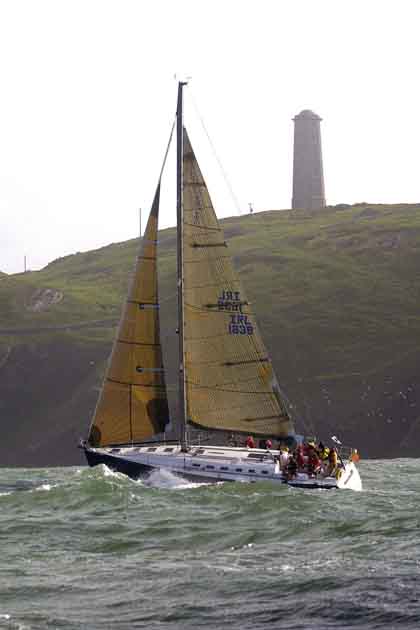
Pictured left: Adrian Lee’s Beneteau Irisha passes below Wicklow head at the start of the 2004 race
The entire sailing community headed by the Irish Sailing Association (ISA) or another body needs to get behind Wicklow and assist it in promoting this 704-mile offshore race as an icon of Ireland's summer sport.
Nowhere was this point more clearly made than in early June when the world's top offshore sailors called in unexpectedly to our South and West coasts.
They came principally in search of wind in leg eight of the Volvo Round the World race. They found little wind, unusually, but before they left they wrote prose worthy of a Failte Ireland copywriter.
In his log Navigator Simon Fisher from ABN AMRO TWO wrote: “Our day started sailing in and out of the mist rolling down off the hills and, as the sun rose and the mist burnt off, it gave way to spectacular views of rolling green hills and a weather-beaten rocky coastline. With castles and towers stationed on each headland, it gives you the feeling of sailing through a scene out of Lord of the Rings.”
COPYRIGHT AFLOAT 2004
See Navigating Round Ireland Tips
More on the Round Ireland Yacht Race:
Round Ireland Yacht Race 2010 Review
Round Ireland Yacht Race, Ireland's top offshore fixture
A Round up of 80 stories on the 2010 Round Ireland Yacht Race



























